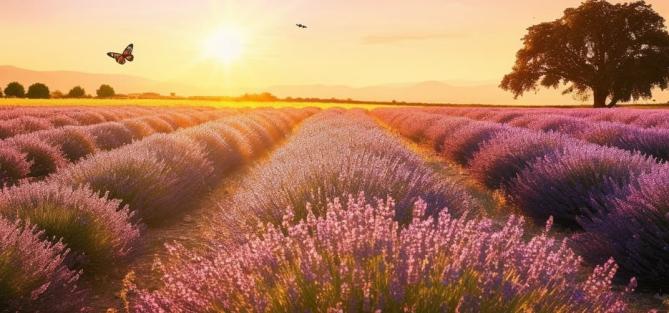MUSEE DE LA LAVANDE LUBERON- 276 Route de Gordes -CS50016- 84220 COUSTELLET
04 90 76 91 23 |

Each day, we share with you our passion for this delicate bleue flower.
Born thousands years ago in the heart of Haute-Provence, it offers us its benefits and all of its charm with its delicious perfume representing south of France.
Contact us for any request or questions, or let yourself be seduced by the organic cosmetics range and niche perfumes we elaborate while having the greatest respect of nature.
Shop le Château du Bois at the Luberon Lavender Museum

Insects and Lavender
Insects and Lavender
Native to the Mediterranean basin, true lavender is one of the iconic plants of Provence. Naturally growing at altitudes above 800 meters, it is inseparable from our landscapes in the southern regions of France. Its subtly scented flowers awaken our senses during walks on steep trails. While it can repel certain pests, it also attracts many pollinator insects. Discover which insects gather on lavender and which ones it repels.
Which Insects Gather on Lavender?
True lavender, also known as fine lavender, is a honey plant loved by pollinator insects. Generous in nature, its flowering period extends from June to September in certain regions of France. This extended blooming period enables it to attract a wide variety of insects.
Throughout its flowering phase, it receives numerous visitors. Butterflies, bees, bumblebees, hoverflies, to name a few, revel in its nectar. Other insects, like spiders, take advantage of this influx to hunt and feed.

Additional small creatures find refuge within the lavender. Small snails, for example, may settle on the lavender stems. Safely hidden from potential predators, they patiently await the return of rain.
In gardens, fruit trees, and vegetable plants, lavender is a favorite. While it attracts many pollinator insects, it also has a reputation for repelling aphids. By planting lavender around your garden, you can encourage fruitful yields and abundant vegetables.
Which Insects Does Lavender Repel?
With nearly 300 molecules present in its essential oil, true lavender possesses a mythical and cherished fragrance used by renowned perfumers. Insects, however, are less affected by the timeless charm of its scent; in fact, lavender can repel many of them.
Lavender and Textile Moths
Lavender is an excellent natural repellent against clothes moths. These textile moths are commonly found in our closets. While they do not target synthetic fabrics, they enjoy creating holes in our finest woolen sweaters.
Interestingly, it's not the adult moths that cause the most damage. In reality, it's their larvae that are the most harmful, as they use textile fibers to build their cocoons.
Fortunately, placing dried lavender sachets in your cupboards is a natural, eco-friendly, and effective solution to prevent infestation. These sachets impart a lovely fresh scent to your clothes while deterring these unwanted insects.
All three lavender varieties—true lavender, spike lavender, and lavandin—are effective against textile moths. It's simply a matter of personal preference!
You can also place a few drops of true lavender, spike lavender, or lavandin essential oil on a ceramic plate, a piece of fabric, or a stone. This will diffuse the lavender fragrance and repel moths.
Lavender as a Natural Mosquito Repellent
The fragrance of true lavender, spike lavender, and lavandin essential oils can repel mosquitoes! The power of their scent drives mosquitoes away, much like citronella, but with a more pleasant aroma! All three essential oil varieties work, but keep in mind that true lavender is the only variety you can apply directly to your skin; spike lavender and lavandin should be diluted.
For maximum effectiveness, place two or three drops of true lavender essential oil behind your ears, on your wrists, behind your knees, and on your ankles. With the scent of lavender on these warm areas and your ankles, mosquitoes will keep their distance, even with their little eyes.
It's not uncommon to see terraces beautifully adorned with pots and planters of lavender. This magnificent perennial plant repels and keeps mosquitoes at bay. By planting lavender in your garden or in containers on balconies and window sills, you can reduce mosquito presence. This way, you can enjoy outdoor meals with family and friends without pesky interruptions, whether it's a barbecue or homemade dishes.
In addition to being a mosquito repellent, lavender also helps soothe itching from mosquito bites. That's why it's a common ingredient in skin-soothing products.
A drop of true lavender essential oil on a mosquito bite can alleviate itching!
Is Lavender Effective Against Lice?
Lavender is a plant with numerous virtues. One of its practical uses is particularly beneficial for young parents, grandparents, and schoolteachers. You might have guessed it—lice, of course!
How to Use Lavender for Lice?
True lavender essential oil works well to get rid of lice. You can apply it behind the ears or add a couple of drops to shampoo.
Be cautious not to get any in the eyes and avoid applying it to children under the age of 3.
After applying lavender oil, it's still necessary to wash everything in the washing machine at a high temperature.
Lavender's Role in the Ecosystem
Lavender flowers are beautiful in gardens and the Provençal landscape. With its subtle fragrance, it often evokes vacation memories and childhood reminiscences.
Our lavender museum has been a testament to our passion for true lavender since 1991. It flourishes naturally in its original birthplace, High-Provence, in the departments of Vaucluse, Alpes-de-Haute-Provence, and Drôme Provençale. This plant is an integral part of our local heritage and has held its AOP label since 1981.

This label serves to protect this natural treasure from cloned lavenders, synthetic products, commercial misuse, and, most importantly, to safeguard consumers by guaranteeing a certain level of quality, as defined in a strict and official specification.
When embarking on an excursion to our Provençal regions, keep in mind that the term "lavender" alone is not regulated enough to identify the lavender variety in question. In the absence of finding AOP-certified "Lavande de Haute-Provence," which guarantees a fine population lavender, ask the seller to allow you to smell the oil to ensure you're not purchasing lavandin or spike lavender essential oil. These varieties produce an oil with a strong camphor scent and should never be applied undiluted to the skin.
Lavender isn't just virtuous in aromatherapy; it provides care to its entire ecosystem. As a honey plant, lavender fields also contribute to biodiversity balance. They nourish pollinators and many other insects. By extension, the population of insects also serves to feed many other small creatures like spiders, amphibians, birds, and more. So, don't hesitate to adopt a lavender plant at home.
